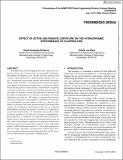Effect of Active and Passive Curvature on the Hydrodynamic Performance of Flapping Fins
Author(s)
Fernández-Gutiérrez, David; van Rees, Wim M
DownloadPublished version (4.646Mb)
Publisher Policy
Publisher Policy
Article is made available in accordance with the publisher's policy and may be subject to US copyright law. Please refer to the publisher's site for terms of use.
Terms of use
Metadata
Show full item recordAbstract
Copyright © 2020 ASME Ray-finned fish swim by flapping their fins, which are composed of bony rays connected by an inextensible membrane. Throughout the flapping cycle, the fins typically undergo both ‘passive’ deformation due to hydrodynamic loading, and ‘active’ deformation arising from internal musculature deforming the fin against the flow. To systematically analyze the impact of fin shape on hydrodynamic performance, a parametric definition of the fin geometry and its modes of deformation is required, consistent with the fin’s material and mechanical properties. In this paper we present a model and algorithm to determine the fin shape corresponding to an arbitrary out-of-plane curvature distribution for each ray. The shape is computed by iteratively enforcing constraints corresponding to membrane inextensibility, and negligible torsional stiffness of the rays. Based on this model, we present a low-order parametrization of fin shapes that capture the predominant deformation modes due to combined hydrodynamic loading and intrinsic actuation, as compared to experimental observations. To demonstrate the model’s ability to provide insight into the effect of curvature on hydrodynamic fin performance, we integrate our algorithm into a 3D Navier-Stokes solver. Using this framework, we present initial results on the cycle-averaged thrust coefficient of a passively and actively deforming generalized trapezoidal caudal fin model at Reynolds number 1500 and Strouhal number 0.3. The results demonstrate that our model, algorithm, and integration with the flow solver form a useful framework to understand the effect of 3D curvature on hydrodynamic performance of flapping fins.
Date issued
2020Department
Massachusetts Institute of Technology. Department of Mechanical EngineeringJournal
American Society of Mechanical Engineers, Fluids Engineering Division (Publication) FEDSM
Publisher
ASME International
Citation
Fernández-Gutiérrez, David and van Rees, Wim M. 2020. "Effect of Active and Passive Curvature on the Hydrodynamic Performance of Flapping Fins." American Society of Mechanical Engineers, Fluids Engineering Division (Publication) FEDSM, 2.
Version: Final published version